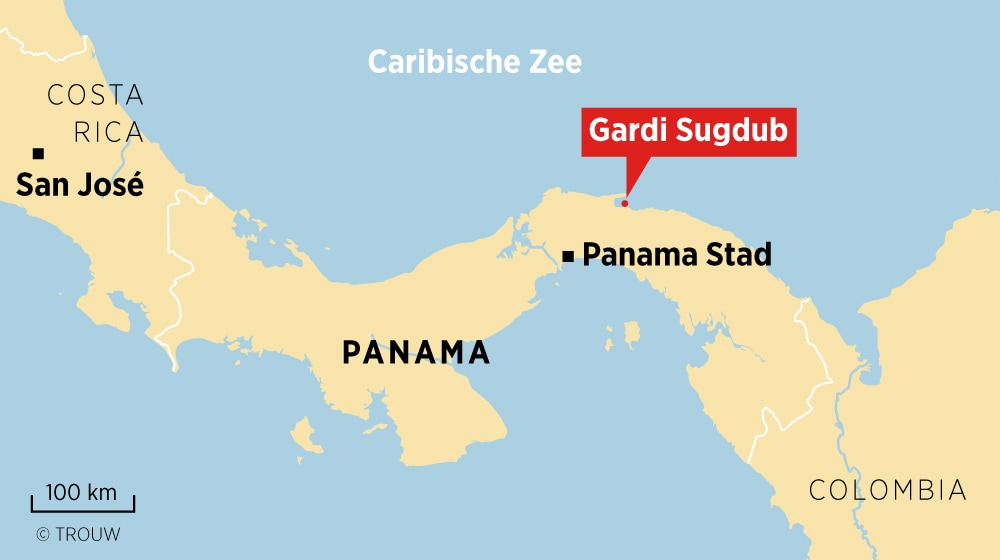The Gunas, an ethnic group from Colombia and Panama, on the island of Gardi Sugdub, are the first of 63 communities along the coast of Panama that government officials and scientists expect will be forced to relocate in the coming decades due to the Rising sea levels. And that movement takes place this week.
It’s a quiet day on the island. Some fishermen are tinkering with the outboard motors of their boats, ready to put to sea. Children, some in school uniforms, others dressed in colorful outfits. cool is mentioned, they chat happily as they find their way through the maze of narrow sandy streets towards the school.
“We are a little sad. Because we are going to leave behind the houses in which we have lived all our lives. We say goodbye to the sea, where we fish, swim, wash and receive tourists. But the same sea is sinking the island little by little,” says Nadín Morales, 24, who is preparing to move with his mother, his uncle and his boyfriend.
Gardi Sugdub is one of the fifty inhabited islands of the Guna Yala territory archipelago. It is only 366 meters long and 137 meters wide. From above it is roughly a pointed oval surrounded by dozens of short piers where residents tie their boats.
Every year, especially when the strong wind hits the sea in November and December, water runs through the streets and laps at the houses. Climate change not only causes sea levels to rise, it also warms the oceans, causing harsher weather, stronger winds, and more intense storms.
An official from Panama’s Housing Ministry said some people have decided to stay on the island until it is no longer safe, without naming a number. The authorities will not force them to leave.
unbearable heat
The Gunas have tried to fortify the edge of the island with rocks, posts and coral, but the sea water keeps coming. “We see more and more how climate change is having a significant impact,” says Morales. “The ebb and flow is at a level that didn’t exist before and the heat is unbearable.”
The Guna autonomous government began thinking about leaving the island two decades ago. That was because he was in danger of being too busy on the small island. The effects of climate change have accelerated that thinking, says Evelio López, a 61-year-old teacher on the island.
He plans to move with members of his family to the new site on the mainland in which the government of Panama has invested $12 million. The concrete houses of Nuevo Cartí are located on a grid of cobblestone streets carved into the lush rainforest just over two kilometers from the port. From there it takes less than ten minutes by boat to Gardi Sugdub.

Leaving the island behind will be a great challenge, says López. “More than 200 years of our culture comes from the sea, so leaving here means a lot. We left the sea, we left our work on the island, now we must set foot on dry land. In a forest. We just have to see what the long-term outcome will be.”
Steven Paton is director of the physics monitoring program at the Smithsonian Institution in Panama. He calls the upcoming measure “a direct consequence of climate change due to rising sea levels.” “These islands are located on average only half a meter above sea level. If that level rises, sooner or later the Gunas will have to abandon all the islands. “That will almost certainly be at the end of this century, or even sooner.”
Lifestyle change
Residents of a small coastal community in Mexico moved inland last year after storms continued to destroy their homes. The Italian lagoon city of Venice is suffering from this, coastal New Zealand residents can relate to it. Climate change is forcing governments to take action. “All coasts around the world are being affected by this at different rates,” Paton said.
In a recent study, the Climate Change Office of Panama’s Ministry of the Environment estimates that the country will lose about 2 percent of its coastal area by 2050 due to rising sea levels. Some 38,000 Panama residents will be affected by this in the near future. And moving them all will cost the country more than a billion dollars, says Ligia Castro, director of climate change at the Ministry of the Environment.
In Gardi Sugdub the women hang the colorful embroidery. cool that they have done in their homes to try to attract the attention of tourists. The island, like many other islands along the coast of Panama, gains a lot from tourism that visits the Caribbean beaches throughout the year.
Braucilio de la Ossa, undersecretary of Carti, the mainland port from where ships leave for Gardi Sugdub, says he plans to move with his family. Some relatives of his wife will remain on the island.
According to him, the biggest challenge for those who move to the interior of the country is the change in lifestyle. “Even though the distance is really small, once we live in the forest, our lives will be completely different.”
Read also: Greenland is in the news every month due to climate change. Do we have to worry?
The eyes of the world tend to focus on Greenland. Logically: the ice melting that contributes the most to global sea level rise. Three recent climate studies were examined.